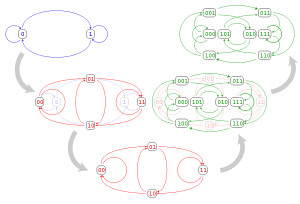You would be surprised to know how much difference a simple idea can make when it comes to the efficiency of an algorithm.
By Gvendolin Fonyó

From computer networks to biological data analysis the graphs named after the Dutch mathematician N. G. de Bruijn are used in a wide variety of scientific fields. But as widespread as they are, up until now there was no space and time-efficient way of building such De Bruijn graphs. Just last year a group of scientists set out to come up with a method to accomplish the task with an efficiency never before seen. Their answer to the question is simple: buffering. Also known as batch-adding data, when updating a graph.
Suppose that you are working on a project that briefly touches on genomes. Writing a small paragraph shouldn’t take too long, right? But then you discover that simply zooming into a graph, to find the information you are looking for isn’t possible. Instead, you have to scroll through tens or potentially hundreds of graphs, because anytime new data became available a new graph had to be created.
The issue
One of the main problems that bioinformatics experts are facing in recent years is the rapidly growing amount of data that is being collected. Assembling such volumes of nucleotide sequences has been posing significant algorithmic challenges. You can magine nucleotides as pieces of Lego in a game of building DNA and RNA. At the same time, the demand for dynamic solutions is also rising. Adding, changing, and deleting aspects of a visual representation of their findings is highly sought after. The biggest challenge on the other hand is combining this mutability feature with space and time efficiency since mutability and compressibility are contradictory by nature.
The science behind it
The way this works is by representing bits of information with circles or rectangles, also known as vertices (singular: vertex), and connections between them with lines (or arrows in the case of a directed graph), also known as edges. Similar to how your house is connected to that building down the road by the street that you live on (two vertices connected to each other by an edge), but to reach the nearest grocery store a few, or a lot, more turns are needed (going from 1 to 6 on the graph below).

Image: AzaToth, public domain, via Wikipedia Commons
A De Bruijn graph works similarly, representing overlaps between sequences in a genome. In biology, a genome is all the genetic information of an organism. While this type of graph gets its name from Nicolaas Govert de Bruijn it was actually discovered by both the British mathematician Irving John Good and De Bruijn independently.

Image: David Eppstein, Public domain, via Wikimedia Commons
Line of attack
The researchers’ approach for implementing mutability is by creating a space-efficient De Bruijn graph with two supporting structures. As requests for adding or deleting information come in, only the corresponding support element is updated. This is where you can see the magic of buffering the data happen. Buffering data means that the information waiting to be added to the graph is first collected in a virtual pool and only once that is filled up can the static or main data structure be updated. Hereby eliminating lots of unnecessary computations and saving computer power. Testing happens by criteria like memory and time needed to complete the requests.
Testing and conclusion
After rigorous testing, the group found that their method, named BufBOSS, is up to five times faster than its closest competitor, Bifrost. When it comes to the time required for adding new sequences, BufBOSS is a strong second in the competition, outcompeted by Bifrost, by only a factor of two, but beating all other contestants by a factor of ten or more.
Their conclusion was that BufBOSS offers attractive trade-offs when it comes to memory, time, and data, compared to its competitors. They, on the other hand, emphasized that some of the other available methods could be greatly improved by further developing them. This means that you do not necessarily have to develop a whole new method if keeping the existing one(s) up to date is a realistic option.
Alanko , J , Alipanahi , B , Settle , J , Boucher , C & Gagie , T 2021 , ‘ Buffering updates enables efficient dynamic de Bruijn graphs ‘ , Computational and Structural Biotechnology Journal , vol. 19 , pp. 4067-4078 . https://doi.org/10.1016/j.csbj.2021.06.047

